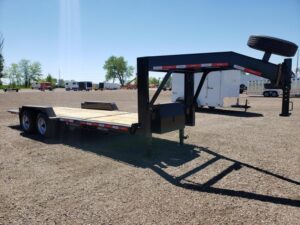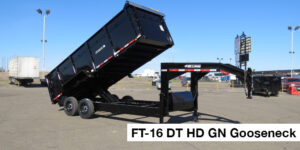The Benefits Of Road Widener Products
Felling Trailers
Gooseneck or Bumper Pull: Which Is Better?
Are you in the market for Felling trailers? Whether you want to transport equipment, move livestock, or go camping like the 77 million Americans who do so every year, one of the most critical decisions you’ll face is how to tow your trailer.
Understanding the differences between gooseneck and bumper pull trailers is essential, regardless of your needs. To ensure you know enough about trailers to make an informed decision, we’ve compiled this comprehensive guide on the gooseneck trailer vs. the bumper pull.
Let’s dive in and discover the perfect Felling trailer option for you.
What’s the Main Difference Between Gooseneck and Bumper Pull Felling Trailers?

When it comes to trailers, there’s a key distinction between gooseneck and bumper pull types: how they connect to a vehicle.
Let’s break it down so you can understand better!
Bumper pull trailers get hitched to vehicles using a ball hitch located on the rear bumper of SUVs, trucks, or motorhomes. It’s a simple setup where trailers attach to the back of vehicles directly.
In contrast, gooseneck trailers have a unique design. They sport a long “neck” extending over the tailgate and sliding onto a ball hitch in the truck’s bed.
This design provides additional stability and allows for greater maneuverability.
Cost of Gooseneck Vs. Bumper Pull
Bumper pull can be your go-to Felling trailer if you want trailers that won’t break the bank. Unlike gooseneck trailers, they are usually lightweight and much smaller, meaning they come with a smaller price tag.
If cost is a major factor in your decision-making process between Felling trailers, a bumper pull trailer can be the perfect fit as it offers a more budget-friendly option while still getting the job done efficiently.
Size, Weight, And Towing Capacity
One thing you should consider when choosing between bumper pull and gooseneck trailers is the weight capacity you require.
Gooseneck trailers can easily handle heavier loads due to their design, which distributes the weight more evenly between the truck and the trailer.
This improves stability, especially when towing over long distances or uneven terrain. Unlike bumper pulls, they need a truck and special equipment.
On the other hand, bumper pull trailers have a small weight capacity and are better suited for short distances and smaller loads. Based on the trailer size, you can tow it behind an RV or SUV.
If you need to transport heavy equipment or large loads regularly, a gooseneck trailer would be the more suitable choice. However, a bumper pull is perfect if you don’t have a truck and require a smaller trailer.
Stability

Due to their weight distribution, gooseneck trailers provide greater stability than bumper pulls. Instead of placing the weight on the rear bumper of the towing vehicle, gooseneck trailers center the weight directly on the truck’s rear axle.
This means that when you’re towing a gooseneck trailer, it won’t wobble or sway as much behind your vehicle, especially during long-distance travel.
If you prefer stability, opting for a gooseneck trailer would be wise.
Gooseneck or Bumper Pull: Which Felling Trailer is Right for You?
No matter what type of trailer you need, Felling Trailers has the perfect match for you and your hauling needs. For people seeking a compact and cost-effective trailer that can be easily towed by an SUV, truck, or RV, the bumper pull is an ideal option.
However, if you require a trailer with substantial towing capacity, own a truck, and prioritize a secure and stable ride, the gooseneck trailer is the perfect fit.
